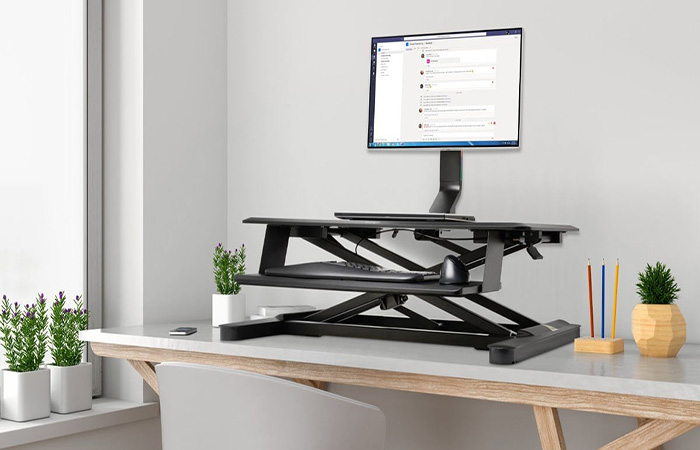Choosing between a standing desk and a normal (traditional) desk depends on various factors, including your health, work habits, and personal preferences. Here’s a detailed comparison to help you decide which one might be right for you:

Standing Desk: Pros and Cons
Pros:
1. Reduces Sedentary Time:
- Standing desks help decrease the amount of time spent sitting, which can lower the risk of developing health issues associated with prolonged sitting, such as obesity, cardiovascular disease, and type 2 diabetes.
2. Improves Posture and Back Health:
- Standing encourages better posture by promoting a more natural spine alignment, which can reduce the risk of developing back and neck pain.
3. Increases Energy and Alertness:
- Standing can help improve circulation and reduce feelings of fatigue, leading to increased energy levels and alertness throughout the day.
4. Potential Weight Management:
- Standing burns more calories than sitting, which can contribute to weight management over time.
Cons:
1. Risk of Discomfort:
- Prolonged standing can lead to discomfort or pain in the legs, feet, and lower back if not managed properly. It can also cause varicose veins.
2. Adjustment Period:
- It may take time for your body to adjust to standing for longer periods, and there may be an initial phase of discomfort.
3. Cost:
- Standing desks are generally more expensive than traditional desks, especially models with adjustable heights.
4. Requires Movement:
- Standing still for long periods can be just as harmful as sitting. It’s essential to move around and take breaks.
Normal Desk: Pros and Cons
Pros:
1. Comfort and Familiarity:
- Most people are accustomed to sitting, and it can be more comfortable, especially for tasks that require fine motor skills or long periods of concentration.
2. Cost-Effective:
- Traditional desks are typically less expensive than standing desks and come in a wide variety of styles and sizes.
3. Wide Availability:
- There is a vast selection of traditional desks to choose from, making it easier to find one that fits your specific needs and space.
4. Less Physical Strain:
- Sitting reduces the strain on the legs and feet compared to standing.
Cons:
1. Health Risks of Prolonged Sitting:
- Extended periods of sitting are associated with various health risks, including obesity, heart disease, and musculoskeletal issues.
2. Poor Posture:
- Sitting can lead to poor posture, especially if the desk and chair are not ergonomically designed, which can cause back and neck pain.
3. Reduced Energy Levels:
- Sitting for long periods can lead to decreased energy levels and increased feelings of fatigue.
Which One is Right for You?
Consider a Standing Desk If:
- You experience discomfort or pain from sitting for long periods.
- You want to reduce sedentary time and the associated health risks.
- You prefer a work setup that allows you to move more frequently.
- You are looking for ways to increase energy and alertness during the day.
- You have the budget for an adjustable standing desk that can switch between sitting and standing positions.
Consider a Normal Desk If:
- You find sitting more comfortable and conducive to concentration and productivity.
- You have limited space or budget for a standing desk.
- Your work involves tasks that require fine motor skills or prolonged periods of sitting.
- You are able to incorporate regular breaks and movement into your routine to mitigate the risks of prolonged sitting.
The Hybrid Approach: Best of Both Worlds
- Adjustable Standing Desks: These desks can switch between sitting and standing positions, offering flexibility. This allows you to stand when you want and sit when needed, promoting a balanced approach to work.
- Desk Converters: If you already have a traditional desk, a desk converter can provide a cost-effective way to create a standing desk setup without replacing your existing furniture.
- Movement and Ergonomics: Regardless of the type of desk, prioritize good ergonomics and regular movement. Ensure your chair and desk are set up to support good posture, and take breaks to stand, stretch, and walk around.
Conclusion
Both standing desks and traditional desks have their own benefits and drawbacks. The best choice depends on your individual needs, preferences, and work habits. If possible, a hybrid approach that allows for both sitting and standing can provide the most flexibility and health benefits. Consider your specific circumstances and try different setups to find what works best for you.

